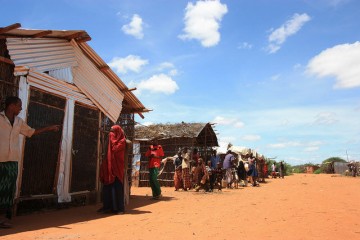
Courtesy of Creative Commons by European Commission DG ECHO in Flickr
In the past few years, hundreds of thousands of refugees have been displaced around the globe, with the Syrian refugee crisis providing the most recent example. As people leave their homes and migrate to a different country, most face an array of ongoing hardships and challenges in accessing basic services, including education. With other responsibilities and priorities, some miss out on learning or have to choose work over school. Given the uncertainty of refugee living conditions, there has been an identified need by governments and institutions to move towards more adaptable and portable delivery modes of education applicable to the cultural and geographical context of refugee camps, so students still have the opportunity to gain the necessary education and skills to build a better life for themselves and their families.
To address some of the educational needs of refugees in the Dadaab refugee camp in Kenya, in 2013, the Faculty of Education engaged in a faculty-wide project in collaboration with Moi University and the Dadaab refugee camp to design, develop and implement a teacher training curriculum for secondary school teachers in the settlement. This was part of a larger collaboration by York University, UBC, Moi University in Kenya, Kenyata university and Foreign Affairs Canada to provide training for teachers. The project was originally initiated by a request from the World University Service of Canada (WUSC) to consider preparing teachers in Dadaab with training, as most teachers were secondary school graduates without a background in pedagogy or learning theory.
In 2013, ETS began its involvement with the project with a review of learning technologies and hardware that are compatible with the students’ learning styles, the infrastructure in Dadaab, and the Kenyan environment. Since then, in collaboration with the people in Dadaab and Moi University, ETS has provided ongoing support for the creation and maintenance of various course material, particularly in the form of a blog hosted in WordPress. In addition, the project has had technology support people on-site in Dadaab to help students navigate the technologies and to provide them with technical assistance in accessing the wireless system in the camp.
According to Dr. Tom Sork, Senior Associate Dean in the Faculty of Education, faculty members and staff have quickly learned to be resilient to changes and to adapt technologies in uncertain security situations to deliver instructional materials. “We initially thought that we might be able to use Blackboard Connect and other kinds of LMS platforms like Moodle. I think that probably we were all overly optimistic in thinking about how well that type of technology would work in the circumstances and how easy it would be for students to learn the technology. But we quickly found out that the student’s access to the internet was less reliable and it was less easy for them to use the technologies, so we’ve started to use other tools to provide information and to distribute assignments” said Sork.
One of such technologies is the instant-messaging mobile device application WhatsApp. Over a year after the first course was offered in this project, students started to use the application extensively to communicate with one another as well as with instructors, type out assignments directly on their mobile phones and submit their work via the comments section on the course blog.
Yet, given the geographical location of the refugee camp and the wider political context, the program also faced a number of other challenges, including unreliable internet access and student absences due to the expense of transportation to the Dadaab learning center. In addition, recruiting and retaining female students in both the primary and secondary education programs also proved to be a challenge, as in Somali culture, women are often marginalized and disadvantaged in educational attainment opportunities.
In order to evaluate the impact of the program on teaching in the Dadaab refugee camp schools, faculty members Dr. Rita L. Irwin and Dr. Samson Nashon also engaged in a research project in 2013, which parallels the delivery of the program. Funded by the Social Sciences and Humanities Research Council of Canada, the project explores how students are thinking about education and their roles about education and thinking about their roles as teachers.
“So far, their results have shown that the program has had a very positive impact on the quality of the teaching and the approaches to teaching are more consistent with what we currently know about learning theory, adapted to the specific cultural context of Dadaab and Somalia” said Sork.
Currently, UBC and Moi University are working to provide support and to accommodate the learning needs of some students who have moved out of the Dadaab refugee camp, due to a recent agreement by the Somali and Kenyan governments to encourage the repatriation of people from Dadaab back to Somalia.
“Overall, we have learned a great deal about teaching and learning in a completely different cultural, economic, political, religious context and that’s been very helpful to the people that have been directly involved. It opens up your eyes when you go to another part of the world and interact with students that you don’t interact with on a daily basis that are facing amazing challenges and security issues. It really makes you realize the importance of having portable and adaptable educational opportunities so that there isn’t a lost generation of youth who miss out on a decent education” said Sork.